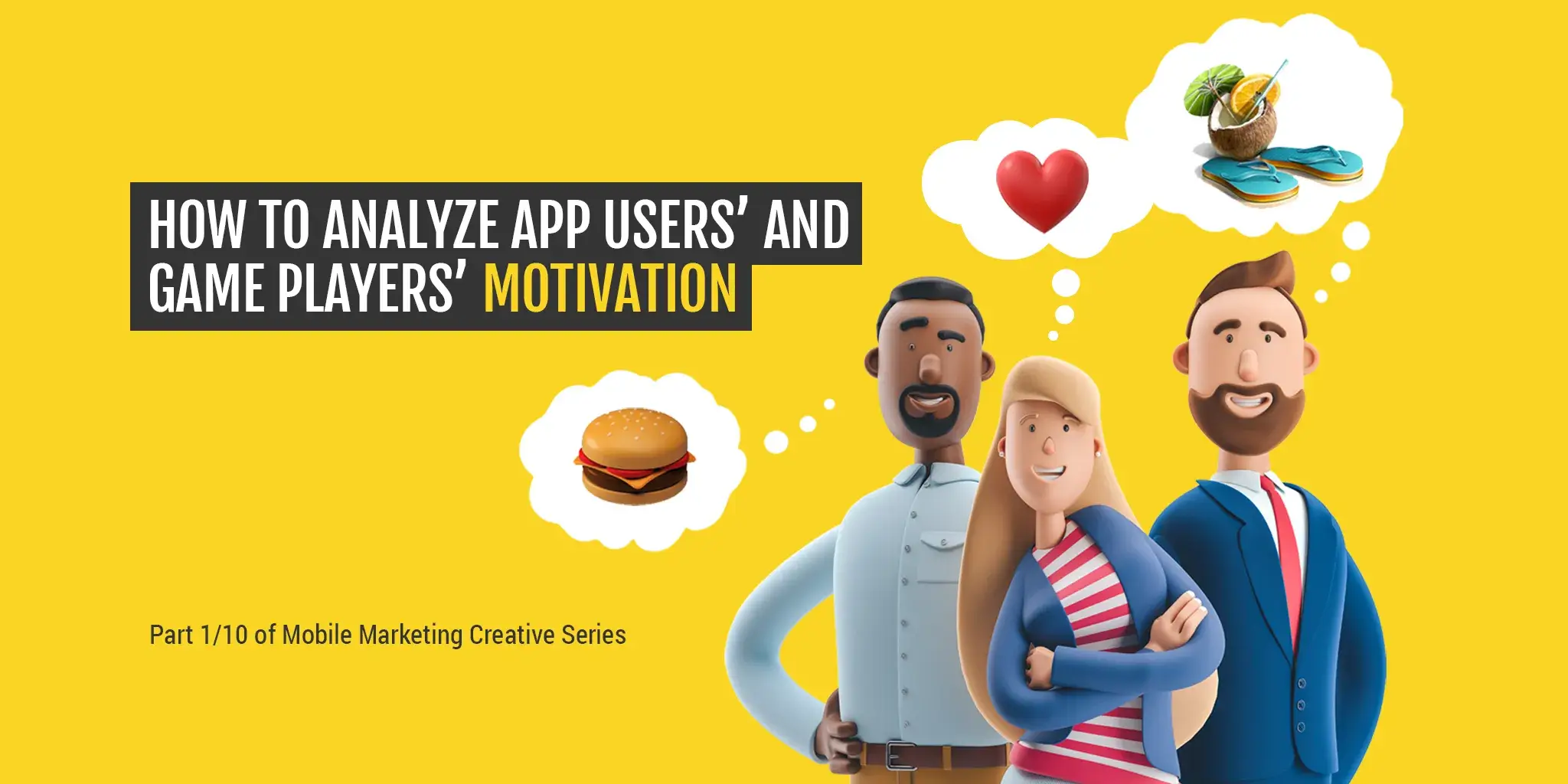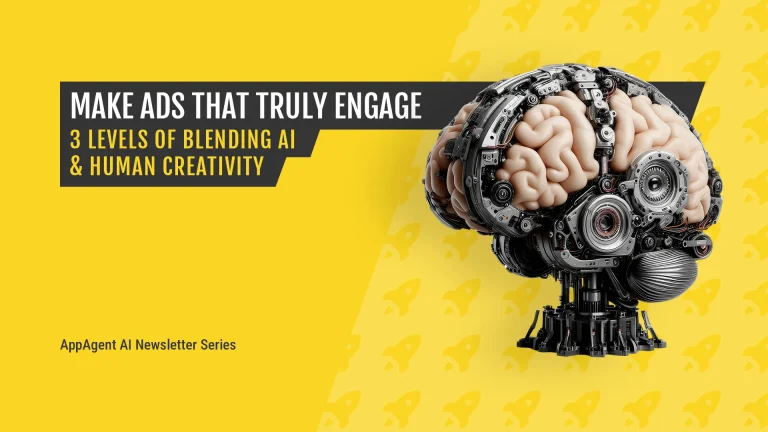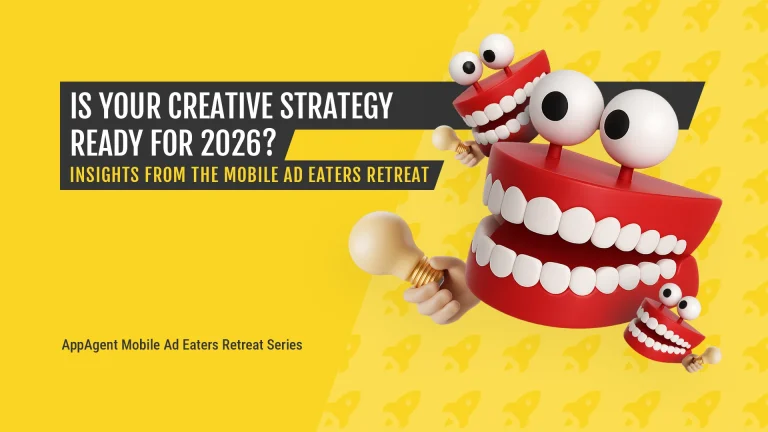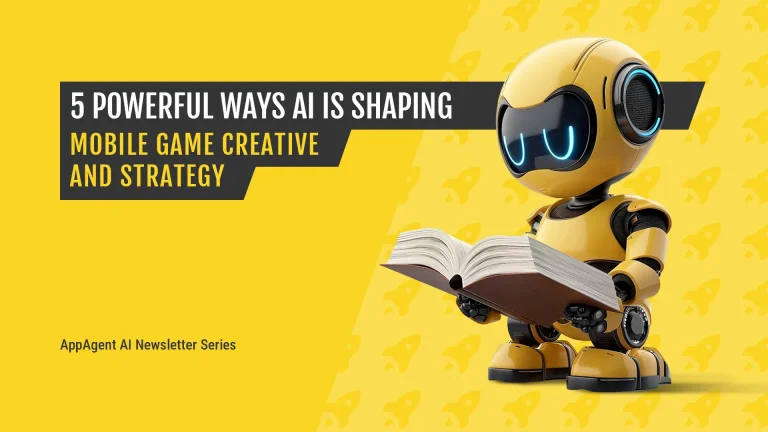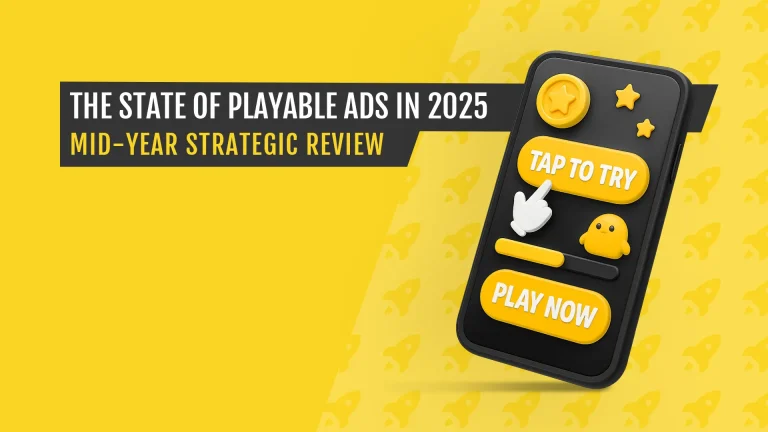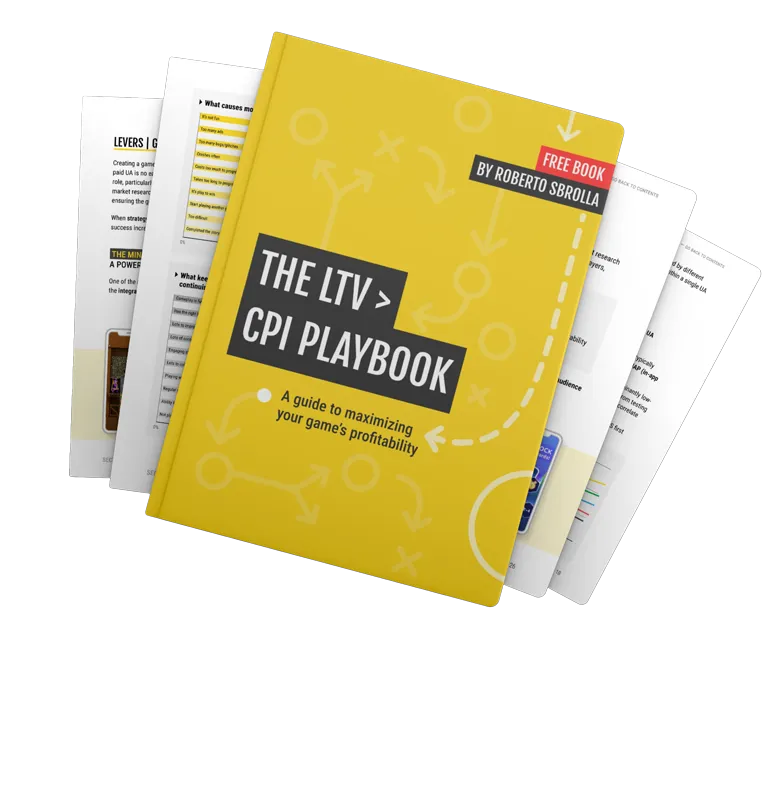This is part one of the Mobile Marketing Creatives Series. We will start with analysis of motivation in game for players as a foundation for this series. In ten episodes, we aim to provide insight and inspiration on creating thumb-stopping visuals to promote your app.

Download the Mobile Ad Creatives eBook today to read the other nine parts of this series. The comprehensive guide includes ten core topics condensed into a practical blueprint with examples from AppAgent’s Creative Team.
In this article, you will learn:
- The pivotal role of user motivators in mobile marketing.
- Effective methods to identify what motivates your users.
- Practical application of these insights in crafting a motivation-based creative strategy.
The Importance of Player and User Motivation in Game Analysis
According to Gonzalo Fasanella, the Chief Marketing Officer (CMO) of Tactile Games, a crucial factor behind Lily’s Garden’s success on the top 100 grossing charts in the US, with around $220K in daily revenues (as reported by Apptica), is their deep understanding of players’ motivators. To gain valuable insights that couldn’t be obtained from game analytics alone. Gonzalo introduced focus groups into the creative process, as he shared in the Deconstructor of Fun podcast.
In the digital space, marketers often rely on vague demographic data, believing that platforms like Facebook will find the right audience for them. However, regardless of the advancements in ad network algorithms, it remains vital to truly comprehend your players or users. You need to understand their motivators, and know how they decide where to invest their precious time and money.
With the impact of IDFA deprecation further affecting targeting accuracy, this understanding becomes more critical than ever before.
How to Conduct User Analysis for Motivation-Based Creatives
To achieve success in the highly competitive mobile market, publishers must capture users’ attention and convey a message that deeply connects with them. Instead of imposing our ideas on customers, our aim is to create what they genuinely desire, isn’t that right?
Here are the 5 ways we uncover motivational drivers at AppAgent:
1. FB AUDIENCE INSIGHTS
For non-gaming apps, our initial approach often involves using Facebook Audience Insights. Facebook provides a wealth of data from various popular Facebook pages. By selecting your primary competitor, you can gain valuable demographic information and insights into the interests of their followers, such as their preferred TV shows, shopping habits, and reading preferences.
Let’s say your app falls within the fitness space. In this case, you might examine Runtastic to discover that their married, middle-aged fans also follow BodyRockTV, participate in Spartan races, and frequently search for new challenges on Active.com.
By gradually piecing together this information, we can create detailed personas that truly aid in understanding what motivates your customers to download your app or game.
2. App Store Review Mining
One of the simplest yet incredibly powerful sources of inspiration is tapping into user reviews on the app stores. By filtering out the negative reviews and complaints, you gain a clear window into understanding what your customers truly appreciate and what doesn’t resonate with them.
3. INTERVIEWS WITH CUSTOMERS AND STREAMERS
Making direct communication with your customers, as mentioned earlier with Tactile Games, holds immense value (listen to this interview with their CMO). The significant advantage is the opportunity to delve deep and ask numerous “whys” to gain a comprehensive understanding of their perspective.
Surprisingly, conducting interviews doesn’t have to be time-consuming. In my personal experience, patterns start to emerge after just 5-10 interviews. Once you stop learning anything new, it’s time to conclude the interviews and apply the fresh insights.
The key to success lies in carefully selecting the people to interview. Prioritize segmentation to ensure unbiased results. Now you might wonder, “Where do I find users for interviews?” Look within your app, your Facebook or Twitch communities, or search for relevant groups online. Don’t hesitate to approach people and offer a remuneration, such as an iTunes Gift Card, for their time and input.
Expert Tip: Engage YouTubers by inviting them for a 90-minute session, either in your office or over a call. Bombard them with questions about their point of view as well as their fans’ perspectives to gain valuable insights.
4. Gamerefinery
A Helsinki-based game intelligence tool has developed 12 player motivations and 8 archetypes based on 600 variables they map across 130,000 mobile games. Each game has its own diagram showing you the profile of core players for the given game compared to the category average.
This tool provides an overview of preferred features and demographics, giving you a clear understanding of what players enjoy in a specific game. By cross-referencing with your direct competitors, you can start recognizing patterns that are not only valuable for marketing but also for the game design itself.
The GameRefinery tool does have a downside: access to Player’s Archetypes is a paid feature, and it focuses solely on games. However, it can still serve as an excellent foundation for conducting your customer surveys and interviews.
5. Quantic Foundry
A market research company specializes in understanding motivation in game for players. Players can participate in a 5-minute survey to receive their personalized gamer motivation profile. The outcome is akin to GameRefinery, offering a visual representation of motivators with a comprehensive breakdown that aids in understanding the nuances of your gamer profile.
For a swift start, consider having the game design lead and marketer fill out the survey from the perspective of core players. Then, compare the results. It can be interesting to identify any disparities between their views and engage in discussions about them.
How to Apply Your Learnings Into a Solid Creative Strategy
The hardest part comes only now – to find the intersections between the results of the research. What works for me is reviewing the inputs and adding layers of characteristics that fit together, enriching the basic player profile. Here’s how the final user profile looks in my head:
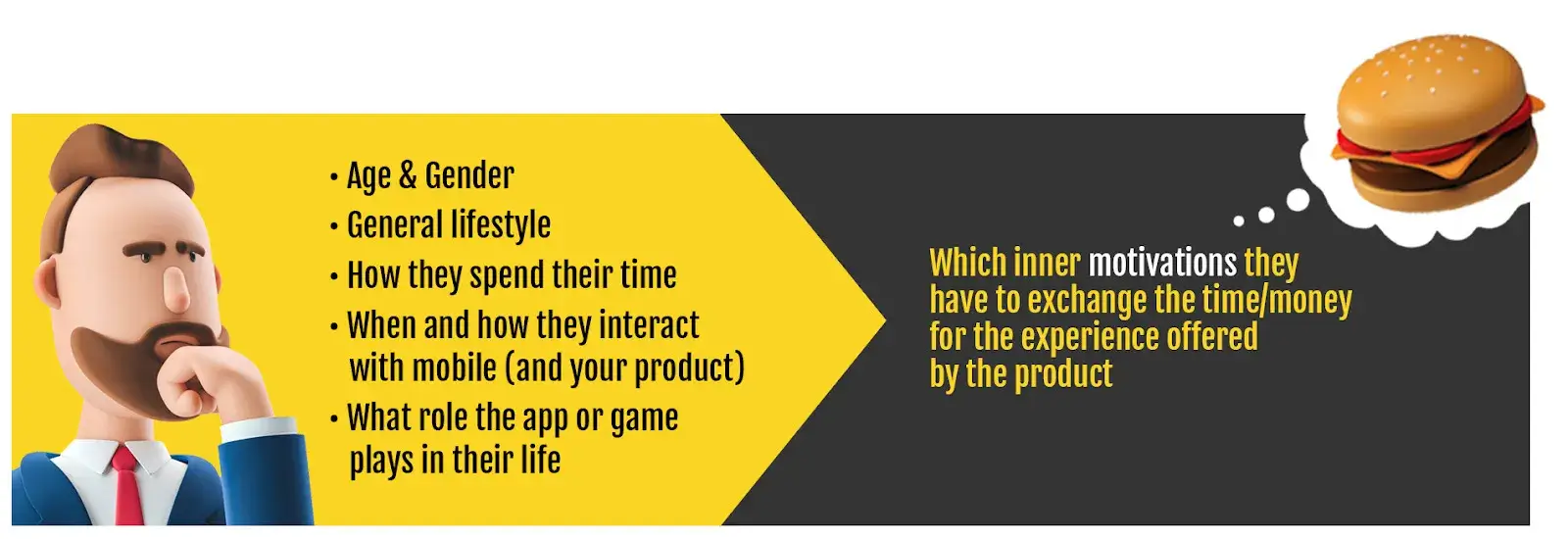
This mental process helps outline 4 to 6 main user motivators. Once you have them identified, you can proceed to the next step: defining visual elements of your app or game that align with these motivators.
Real-Life examples of user analysis
1. Gaming
For Clash of Clans, we have identified various player motivators using the GameRefinery framework, such as Social – Competing Against Others and Management – Strategic Planning.
One of the most powerful motivation in game for players is the sense of progression.
To optimize the store listing or mobile ad, the focus should be on showcasing the village’s transformation from a simple field to the grandest town hall with strong defenses. Here’s a successful ad creative by AppAgent that effectively plays on the motivator of progression with an exciting twist:
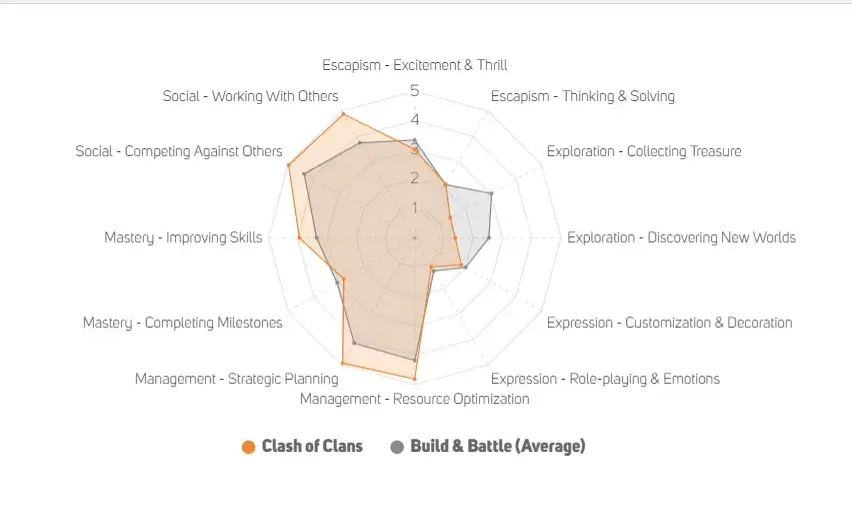
2. Non-Gaming
A common motivator of job seekers is the desire to feel valuable and contribute to an appreciative company.
AppAgent’s creative team crafted an ad for Pockethunt that resonates with the emotions users might experience in their current job, while also highlighting that true satisfaction lies in finding the perfect match:
Closing Remarks
Companies often tend to be fixated on the competition, but their primary focus should be on understanding the customer. Discovering what motivates customers makes it easier to excite and convert them into loyal patrons.
Relying solely on quantitative data is not enough; conducting qualitative research and understanding what truly drives people will provide a significant competitive edge. By delving into the emotions and needs of customers, companies can create more compelling products and experiences, ultimately leading to greater success.
Mobile Ad Creatives eBook
How to Design Ads and App Store Creatives
A comprehensive guide to designing thumb-stopping visuals that will grow your user base and revenue.
How to analyse app user’s and motivation in game for players?
The key to the success of your mobile app or game is to understand who are your players or users, what are their motivators and how they decide where to invest valuable time or even money.
These are the 5 ways how we mine motivational drivers:
1. FB audience insights
2. App Store reviews
3. Interviews with customers and streamers
4. GameRefinery
5. Quantic FoundryThis process leads to outlining 4-6 main motivators which help you to define visual elements of your app or game, matching these motivators.
